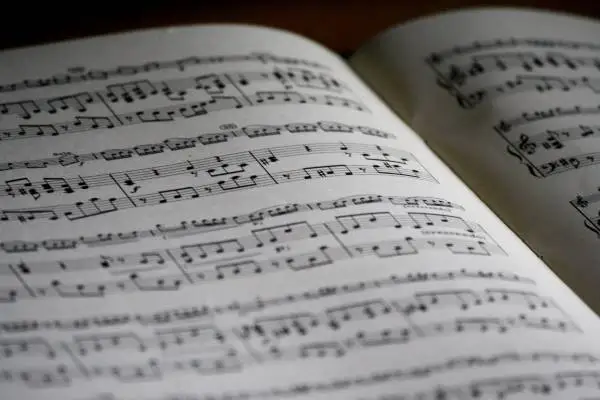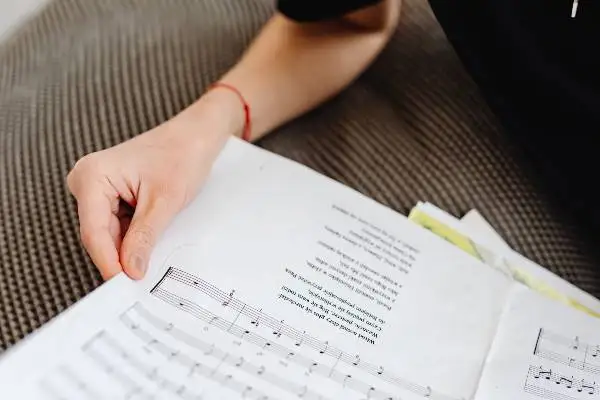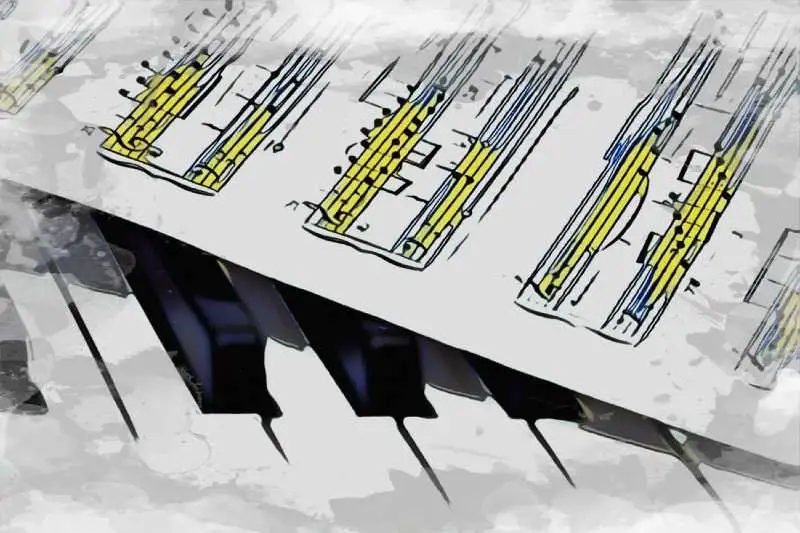Are you trying to crack the mystery behind instrumental and vocal melodies? Melody is one of the most important and basic elements of music, so understanding how melodies work is an absolute must for any musician.
In this article, we'll be tackling all of your burning questions like, "What is melody in music?", "How do music melodies work?", and help you identify key melodies throughout history, ranging from classical music to pop music. Let's dive into it!
What Is A Melody?
In its simplest form, the definition of melody boils down to a sequence of musical notes played in a particular order, called a music phrase or a melodic phrase. Anything that creates distinct music notes can create a melody. Melodies can be made up of the same, single note played multiple times, or multiple notes, usually within some sort of scale as discussed below.
For example, when you sing or play "happy birthday" it's still the same melody. The way that the main phrases are sung in "happy birthday" remains the same since the melodic line is passed from one person to another.
In music notation, melodies are simply lines of multiple notes, usually ending at a bar or at the end of a particular measure. In a musical composition, melodies can be complex or incredibly simple, but most are designed to be memorable.

When you "can't get a song out of your head", you're most likely referring to the main melodic line. Vocal melodies, especially in pop music, are designed to be sticky, which is what makes them so important. Melodies are a huge part of what makes music memorable. While there are multiple elements that make up a single melody, a well-crafted melodic musical phrase is designed to feel effortless.
Melodies usually stand out from the rest of the piece by offering new ideas to the musical composition. For example, when a band performs a song, the drums, bass parts, and backing piano will more or less continue to play similar parts throughout the entire song according to the chord progression . The vocalist, on the other hand, takes charge of the melody.
The vocalist may use some of the same notes from the chord progression, but their part naturally stands out amongst the rest of the instrumental backing since their vocal music melody constantly introduces new, melodic phrases to a piece of music. The listener perceives the melody more easily since it sticks out amongst the rest of the chords and instrumentation being played at any current time.
Elements of a Melody
So, what is a melody composed of? In musical compositions, the central components of a melodic phrase can be attributed to the following:
Pitch
A melody is made up of multiple notes of pitches of sound. It's possible to have a melody with only a few pitches that still "works". One good example is "One Note Samba":
More often than not, melodies utilize multiple pitches to add interest and create more of a melodic arc in a piece of music. However, there are plenty of ways to successfully write a melody , so don't try to get hung up on one element on its own.
Contour
The contour or the shape of the melody is pretty self-explanatory. Quite literally, this is the shape of the sequence of notes or melody in a piece of music. You can see certain arcs while writing melodic phrases on sheet music.
Some melodies will make large leaps from one note to another, while others will move in a stepwise motion across a sheet of music. Composers deliberately think about the shape of their melodic phrases to create different feelings and build energy throughout a song.
Range
Melodic range refers to the distance between the lowest and highest pitches in a melody. The range will limit which musicians can sing or sometimes play a particular melody. A narrow range is easier to perform while a wider range can be more difficult, but potentially more interesting for the listener as a more complex melody.
Intervals
Intervals refer to the distance between certain types of pitches or notes on a music scale. Generally speaking, an interval is classified by a note's relation to the first note in a particular key, otherwise the tonic. This distance is usually measured in semitones. Some of the most common intervals are as follows:
Unison
These are notes are played at the same pitch with no distance between each other.
Minor 2nd
This note is 1 semitone above the tonic (or first note) of a scale.
Major 2nd
This note is 2 semitones above the tonic (or first note) of a scale.
Minor 3rd
This note is 3 semitones above the tonic (or first note) of a scale.
Major 3rd
This note is 4 semitones above the tonic (or first note) of a scale.
Perfect 4th
This note is 5 semitones above the tonic (or first note) of a scale.
Augmented 4th or Diminished 5th
This note is 6 semitones above the tonic (or first note) of a scale.
Perfect 5th
This note is 7 semitones above the tonic (or first note) of a scale.
Minor 6th
This note is 8 semitones above the tonic (or first note) of a scale.
Major 6th
This note is 9 semitones above the tonic (or first note) of a scale.
Minor 7th
This note is 10 semitones above the tonic (or first note) of a scale.
Major 7th
This note is 11 semitones above the tonic (or first note) of a scale.
Octave
This note is 12 semitones above the tonic (or first note) of a scale. It's the same note as the tonic, played higher or lower than the reference note.
When writing a melody , it can be helpful to keep intervals in mind so that you can find proven ways to transition in between notes.

Structure
This refers to how a melody is built. If it's a lyrical melody, a melodic line can be structured around a lyric or phrase. Other melodies may be built around a certain rhythm or pattern within a piece of music.
Scale
A scale is a collection of notes in a particular pattern within a key, or family of notes in music. You can use different scales to denote different feelings and sounds in melodies. Melodies are often structured around a particular scale. Even if you don't have extensive knowledge of music theory, you probably use melodic scales intuitively.
Motif
A motif is simply a section or part of a melody that's repeated throughout the piece. For example, the chorus of a song likely has a lot of melody motifs that show up time and time again throughout the piece of music.
In the world of scoring, a motif can be used to announce the introduction or reappearance of a particular character. For example, whenever Darth Vader entered a scene in Star Wars , this motif could be heard:
While motifs are usually smaller collections of repeated notes, a greater repeated section or melodic idea might be considered a musical theme.
Phrasing
Phrasing or phrases in a song can feel like a musical sentence. Don't get me wrong, this doesn't mean that a phrase needs to be a complete sentence, but a musical phrase speaks to the way a melody is spaced out over a line of music. A good example is in "Happy Birthday". We sing "Happy birthday to you," and pause before singing the next set of lyrics.
Therefore, phasing speaks to the number of words and pitches in a melody. It's not uncommon for four phrases to make up a chorus in popular music, or for phrases to wrap up at the end of a measure. Phrases help popular music keep cadence . A group of phrases will often hold or repeat the same or similar melodies.
Rhythm
Rhythm speaks to the way that you're expressing a particular melody. There are many different ways to articulate the same set of notes. Rhythm can tell you what type of note your melody is played on, and what it sounds like in between each of the notes in your melody.
Melody Vs. Harmony: What's The Difference?
Melodies and harmonies are often confused with one another when they are in fact, entirely different things. The biggest difference is that melodies stand on their own. Harmonies are played in relation to a particular melody, usually with a specific pattern of intervals to create a sonically pleasing combination of notes.
Harmony may also be referred to as a counter melody. Typically, harmonies support the original melody without detracting too much attention from the main melodic phrase. Harmony can be higher or lower in pitches than a melody.
You'll often find harmonies are sung by backing vocalists, while a melody is sung by the main vocalist. In terms of vocal parts, alto singers are more likely to sing harmonies while soprano singers are known to take on the melody in most cases.

Types of Melodies
When it comes to modern and classical music, most melodies are classified by the way in which the pitches relate to one another directionally speaking. You can describe the way melodies move with the terms ascending and descending.
Ascending
An ascending melody refers to a section of pitches in which each pitch goes up in tone and frequency.
Descending
A descending melody lowers in pitch throughout the melodic phrase.
Melodic Motion
The melodic motion speaks to how a string of notes or melodies moves throughout a particular phrase. Does one pitch flow into a neighboring note? Or does the instrumentalist jump from one large interval to the next? These two types of motion are referred to as conjunct and disjunct melodic motion.
Conjunct
Conjunct melody is when a melodic phrase rises and lowers in pitch usually in a stepwise fashion. A conjunct motion could be as simple as moving up and down a scale written as the backing melody of a composition. A great example of conjunct motion can be found in "Ode to Joy". Notice how the notes of the melody move in a stepwise motion seamlessly from one note to another, creating the central melodies throughout the composition.
Disjunct
Disjunct motion is characterized by large skips throughout the melody, often making larger intervals skipping past adjacent notes. You can find great examples of disjunct motion in renditions of the Star-Spangled Banner, which can be difficult for novice musicians and vocalists to sing since there are a lot of melodic skips.
Mix
Mixed motion is simply a cross between disjunct and conjunct motion. Switching between the two melodic motion types can help create contrast and interest throughout a musical composition.
In addition to these more general types, you'll also find more specific forms of melodic motion when two melodies are played at the same time:
Parallel
Parallel motion is when two melodies move together ascending or descending, keeping the same intervals between phrasing.
Similar
Similar motion is exactly like parallel motion, except the melodies both need to be ascending or descending. The same direction and the same time in a tune.
Contrary
Contrary motion is when one melody descends while the other ascends and vice versa. When this happens at the same intervals, it's called strict contrary motion.
Oblique
Oblique motion is when one melody stays on the same note while the other moves in any fashion creating a contrast between the two melodic phrases.
History of Melodies In Music
Music is in our blood. The history of music goes back at least 35,000 years, but some experts feel that we've been singing as long as we've been able to speak. It's no surprise that melodies have been passed down from one generation to the next, well before they were documented.
Nevertheless, one of the oldest documented melodies is known as Hurrian Hymn #6 which sounds like this:
The melody was found on clay fragments, written sometime in the 14th century BC. This melody was most likely played on the lyre and harp.
There are obviously many gaps in our melodic history, but we can see the origins of another melodic style in a Greek piece entitled Seikilos Epitaph, which was most likely played on the lyre:
Enter classical music, we start to see more variation, especially in terms of songs that are more upbeat with the introduction of the harpsichord. We can start to see melodic variations, with melody straying further away from the instrumental backing with the introduction of classical music pieces played by composers like Mozart:
Over time, music evolved into a variety of genres including bluegrass, jazz, rock, disco, R&B, hip hop, folk, doo-wop, and the list continues to evolve today. Melodies within specific genres may take to particular scale structures more than others, but there are no limits to the construction of melodies.
Melody In Music Today
Today, there are endless possibilities to melodies as we know them. If you look at the popular charts, you'll find the sparse note, simplistic melodies, and equally complicated melodies with wide ranges well-loved by the same people.
While songs within the same genres of music may construct a melody in a particular way, there really are no bounds since a melody is just a single aspect of music. As you learn how to write a melody, let yourself experiment and tinker with plenty of different possibilities. There's no one right way to make music. Enjoy crafting your own melody lines!





